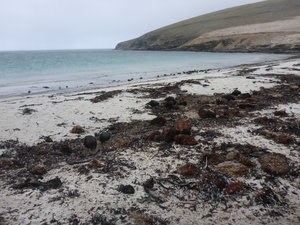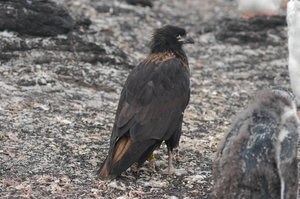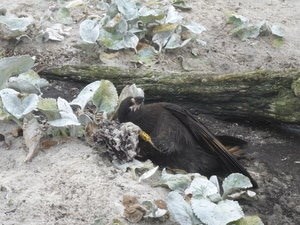Out in the Field
Posted on in In the Field by Katie Harrington, Research Associate and Former Conservation Science Trainee
I have just returned to Hawk Mountain from a two-month field effort conducting behavioral and dietary studies of Striated Caracaras, or Johnny Rooks, as the locals call them, in the Falkland Islands. Set off from the coast of South America in the South Atlantic, in a back eddy of the circumpolar current, the Falklands embody the sense of expedition, expanse, and natural beauty that would make any graduate student –especially me– weak in the knees.
Being my third visit to Saunders Island, human population of 4, I had a sense of what to expect: gales and squalls, immense starry skies, long summer days, and thousands of birds. I stayed in a cottage at the Farm Settlement and shared the company of my hosts, the Pole-Evans family, at their farmhouse in the late evenings. During the days, I would figuratively saddle up on an ATV, part the sheep, brake for hens, and set off on the undulating dirt track toward the Neck 10 miles to the northwest, where I’d spend the day with roughly 100, mostly juvenile, Johnny Rooks.
It’s an amazing study population that Dr. Keith Bildstein began banding in 2006. Over 80 percent of the individuals I observed I could call by the name on their leg band, Z26, K27, G22, etc., which allowed me not only to observe population-level patterns, but also to learn more about different individuals’ behavior over space and time, that is, who hangs out where and with whom, for how long, and doing what.

For my graduate work at Moss Landing Marine Labs in Monterey Bay, California, I am investigating the role the Rooks play in energy flow in their marine environment. It’s well known that Johnny Rooks associate with seabird colonies, but it’s less understood the extent to which they depend on invertebrates, both terrestrial and marine, as a nutritional resource. You might not think a raptor, formerly persecuted for slaying sheep and frequently labeled a penguin-killer, would spend hours each day silently and determinedly raking for larvae in accumulated kelp wrack. I certainly didn’t, but they do! It’s this behavior I set out to learn more about.
Layered in merino wool, I’d sit for hours, recording three different layers of resolution, from macro to micro: (1) total time an individual Rook spent foraging within the kelp wrack, (2) proportion of time spent actively digging and ingesting invertebrates versus a catalogue of other behaviors within a 4-min period, and (3) ingestion rates within a 30-sec period. Combined, these layers will help me better understand kelp raking as a foraging strategy, and the implications of changing social or climatic conditions.

A second goal of mine was to deploy and retrieve accelerometers that I had built before leaving San Francisco. Having learned to wire, solder, and program the archival Arduino microloggers, I had my fingers crossed that I wouldn’t lose them forever. Rooks are wily and persistent, especially when it comes to disarming and destroying miniature gadgets, so I wasn’t entirely sure my plan would work. Luckily, by using two layers of heat shrink and Tesa tape and then tail mounting the units, it did! Keith warned me going into this, saying that it’s easy to trap Rooks, but it’s harder to retrap the one that's wearing your unit. Although, with a single snare and cubed mutton, we fortunately “lassoed” all six of our “accelerometered” birds! What a rodeo! I’ll now be able to plug these data into visualization software, and by syncing the movement records with behavioral observations I conducted while the birds wore the units, I’ll be able to extract activity signatures and quantify total time spent doing each activity for a twenty-four hour period. I’m deeply indebted to banded Rooks X36, P25, V26, Z26, M26 and K27. Thank you young Rooks!
For many of my days, I’d sit still and observe, doing my best to blend in with the environment. Frequently, when I would put down my binoculars I’d find a Gentoo Penguin peering closely at me, within arm’s reach, or a pair of King Penguins slowly waddling past me toward the water. Or I’d be closely watching one Rook raking while another, often a recently fledged one or a juvenile, would sidle up beside me to stare at me, head turning upside down for a better look, or to play with my thermos. On many days there would be a Sea Lion hunting and preying upon Gentoos 100m offshore, grabbing and slapping the penguin’s body back and forth on the water. Southern Giant Petrels would get the first go at the remaining carcass, but once it washed ashore it became a hierarchical battle between them, the Rooks, and the local Turkey Vultures. Southern Crested Caracaras steered clear with Petrels around. Not to say they didn’t hold weight at the Neck though, as whenever they flew over, the gulls, oystercatchers and Rooks all would flush in alarm.

While the Rooks spent most of their days at the Neck foraging or digesting, the four recently fledged Rooks that arrived midsummer introduced me to another side of the species. I’d watch and try not to laugh as they ran toward inanimate, inedible objects and kickboxed them, grabbing on and stumbling over themselves while they held on their “toys.” They’d lie there on their side, partially flapping, partially kicking, and doing what I could only call playing with the objects. Energetic and clumsy, they seemed to be learning to navigate their world. I could certainly relate to their seeming enthusiasm.
Working with the Rooks has been an incredible opportunity to contribute information on a little-studied species, engage with the amazing South Atlantic ecosystem, and build relationships with local residents who have been so generous in supporting our work. Keith and I will return to the islands in July to present our findings at a “Farmer’s Week” get-together in Stanley, the capital of the islands, before continuing to Saunders Island to rejoin the Rooks. Until then, I’m sure they’ll be raking away, running under fences, and continuing to perplex and delight, and, perhaps, frustrate all who encounter them.